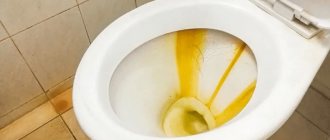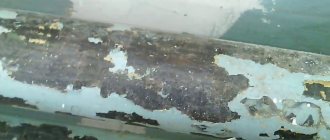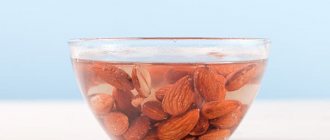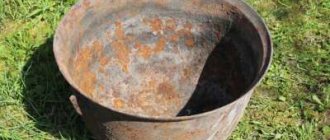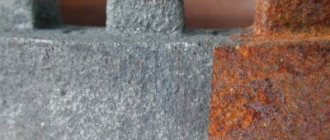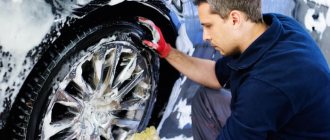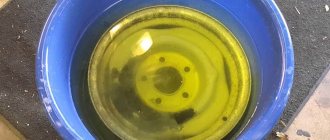01/20/2022 Author: VT-METALL
From this material you will learn
:
- Causes of metal corrosion under paintwork
- 4 stages of metal processing before painting
- Methods of mechanical processing of metal before painting
- Chemical treatment of metal before painting
- Chemical preparation of ferrous metals for painting
- Chemical preparation of non-ferrous metals for painting
Metal processing before painting is necessary to apply high-quality paintwork and prevent further corrosion. If the preparation stage is skipped, the paint layer on the product will not last long, which will lead to its premature aging.
Both mechanical and chemical treatment of the metal surface is used before applying a layer of paint. The first is to remove rust and flaws, the second is to degrease, prime, and phosphate. You will learn how to properly process metal before painting from our material.
Causes of metal corrosion under paintwork
Paint and varnish coatings are not able to provide metal with complete protection from moisture, acting on the principle of a semi-permeable membrane. Operation in difficult climatic conditions with high humidity and temperature fluctuations leads to the fact that, under the influence of osmotic pressure, moisture enters the product itself through the pores of the coating. As a result, corrosion processes are started on the metal substrate. Rust negatively affects the adhesion between the structure and the paint layer, so over time the latter begins to peel off.
The use of chemicals to treat metal before painting results in the formation of conversion coatings. They improve the physical, mechanical and protective characteristics of the paint layer, extending the service life of painted metal surfaces.
VT-metall offers services:
Metal processing before painting requires mandatory cleaning and the creation of a protective conversion coating. Coatings are inorganic compounds that form on the surface of metals under the influence of special chemical compounds. These can be phosphate, chromate and oxide compounds - it all depends on the preparation used.
Due to the microcrystalline structure, conversion coatings have a branched surface, which allows them to form strong adhesive bonds with the paint layer.
This type of coating is stable and inhibits under-film corrosion. And when scratches or chips appear on the paint layer, rust is prevented from spreading throughout the entire product.
Corrosion is classified according to the degree of damage to steel as follows:
- Corrosion stains: characterized by shallow penetration depth. Such corrosion spreads broadly, not deep into the iron.
- Pitting is small spots that penetrate deep into the body of a material. With further development of pitting corrosion, through holes appear on the steel.
- Through corrosion is through damage to the material.
- Under-film corrosion: pockets of rust form under the surface of the coating. Layers of paint in places where rust has formed swell. But sometimes subfilm corrosion remains unnoticed until the steel undergoes complete destruction.
Material processing
Treating the material against rust before painting can be done using the following methods:
- mechanical;
- chemical;
- thermal.
Methods of mechanical processing of metal before painting
Such metal processing is carried out using hand or mechanized tools using a variety of abrasive materials and mechanical installations.
Due to mechanical treatment, scale, traces of corrosion and charring, oxides, remnants of the previous coating, coarse dirt, sand and slag are removed from the surface. In addition, this approach allows you to create a rough surface, which has a positive effect on the adhesion of the paint layer.
Before mechanical cleaning, products with traces of oil are cleaned with white spirit, solvent R-4 or an alkaline aqueous solution. If the metal has a thickness of 6 mm or more, significant organic layers of contaminants can be removed by gas-flame cleaning with an oxy-acetylene torch.
Hand tools, such as wire brushes, spatulas, scrapers, are used for a small amount of work. Whereas large volumes are handled mechanically, using brushes, cutters, abrasive wheels, an endless abrasive belt, and needle guns.
Tumbling and vibroabrasive processing can also be used - both methods involve the use of bulk abrasives.
Galtovka
is a method of treating metal before painting in which small parts are cleaned in rotating drums. There are two types of tumbling: dry, that is, only abrasive is used, and wet. In the second case, the abrasive is supplemented with special liquid compounds. In any case, scale, burrs, and irregularities are removed from the surface of the products, and roughness is reduced.
Vibroabrasive processing
is a mechanical or chemical-mechanical process by which tiny particles of metal and its oxides are removed from the workpiece. It is important that this approach helps smooth out small defects due to many micro-impacts with abrasive.
Metal blasting is also widely used today.
using abrasive materials. This can be dry or water abrasive cleaning, as well as water blast cleaning. All of the above types of metal processing before painting require the use of specialized equipment. The role of abrasives is usually played by metal sand or shot, glass beads, and slag.
Abrasive blast cleaning is only suitable for metal with a thickness of 3 mm or more. Processing of thin-walled products can be carried out only on the condition that it does not lead to a change in the geometry of the object. Upon completion of dry cleaning, the products are removed from dust and degreased, if required.
After this procedure, the metal is very active, so it is important to coat it with a primer or paint as soon as possible to prevent the formation of secondary corrosion. For the same reason, during mechanical cleaning, you need to ensure that the air humidity does not go beyond 85%, and the temperature of the product is at least 3 °C above the dew point.
Mechanical methods of metal processing before painting differ favorably from others in that they are suitable for products made of ferrous and non-ferrous metals, regardless of their dimensions. Also, the structure is prepared without moving it to other workshops - right at the workplace.
Among the disadvantages of this method are the high price and high labor costs. In addition, it cannot be used for thin-walled products with complex configurations.
Mechanical processing creates a rough surface, which means better adhesion of the paint and varnish coating is ensured. However, the method is not able to protect metal from rust. You can achieve two goals at once using chemical methods.
Where rust must be removed before painting
It is useless to paint rusty surfaces - the coating will begin to swell and peel off.
Almost all metal objects suffer from the corrosive influence: tools, electrical appliances, household items. Car enthusiasts are often busy solving the problem: rusty spots do not paint car bodies. But household items are also susceptible to this “disease”: faucets, metal pipes, window grilles, door handles, radiators.
The reason why a layer of rust forms is the influence of unfavorable external factors, primarily water.
A chemical reaction occurs on the metal surface, because of which the previous appearance of the thing and its functional qualities disappear. Before painting, rust treatment is required. Otherwise, the new coating will begin to swell and peel off.
Chemical treatment of metal before painting
This technology involves working in several stages and using aqueous solutions of special compositions. The number of stages is selected in accordance with the type of metal, surface condition, and future operating conditions of the products.
Most often, the process of chemical treatment of metal before painting includes the following steps:
:
- Degreasing, cleaning.
- Removing traces of rust and oxides.
- Activation.
- Conversion processing.
- Final treatment or passivation, washing with demineralized water.
- Drying.
After each stage, the products are washed with water, in some cases even twice.
If you plan to use the structure in harsh conditions, that is, outdoors, perform all the described preparations with the application of protective conversion coatings. For products that will be used indoors at normal humidity, only degreasing is sufficient.
If the surface of a ferrous metal structure has only been cleaned from traces of grease, it is protected by passivation from secondary corrosion during the drying process. It is recommended to use products based on tri- or hexavalent chromium. It is important to emphasize that solutions of sodium nitrite, tri- and monoethanolamine cannot be used here.
Process Features
The disadvantages of using wheels include the high consumption of abrasive tools and the need for skill in such work.
Sandblasting and waterjet cleaning are indispensable when working in hard-to-reach places that cannot be reached with a brush or wheel. The technology allows you to get rid of not only rust, but also carbon deposits, scale, and old paint.
The sandblasting process involves exposing metal to sand jets supplied under pressure. The installation includes a compressor, a container with sand and a gun for supplying abrasive.
When waterjetting or hydrosandblasting, a mixture of abrasive material and water is supplied. Delivery occurs at high, low or ultra-high pressure levels. Low intensity saves material, but after the surface dries, signs of secondary corrosion appear.
High supply pressure almost completely removes all deposits. In some areas, traces of black oxides and durable coating sometimes appear. Ultra-high abrasive supply pressure allows you to obtain an absolutely clean surface.
Both methods are only applicable in production environments.
Chemical preparation of ferrous metals for painting
The treatment of metal before painting with the formation of conversion coatings also largely depends on the type of metal.
Ferrous metals, which include steel and cast iron, are phosphated. Aluminum, magnesium and alloys based on them are chromated. For zinc and cadmium, galvanized steel and zinc alloys, both types of processing are allowed.
According to their composition, phosphate coatings are divided into crystalline or zinc phosphate and amorphous, that is, iron phosphate. The former have higher resistance to rust, so they are recommended to be chosen for metal processing before painting if the structure will be used in difficult climatic conditions.
It is zinc phosphating that makes it possible to prepare the surfaces of automobile bodies, agricultural machinery, and building structures. Iron phosphating is necessary for processing blanks of metal furniture, household appliances, lamps, etc.
The entire phosphating process includes at least 5-6 stages, and immersion and spraying methods can be used. If this treatment is combined with degreasing, it is possible to reduce the number of stages to 3-4.
The most modern phosphating compounds are designed to improve the consumer properties of phosphate coatings and the environmental component of this type of metal processing before painting. To do this, nickel and manganese cations are introduced into the composition, and the proportion of zinc is also reduced.
If you liked the article, please share it
Previously on the topic:
Share
Chemical preparation of non-ferrous metals for painting
When non-ferrous metals are processed together with steel, they try to use phosphating. It should be noted that next comes the passivation stage, which must be present in the processing of any metals before painting.
Taking into account the further operating conditions of the structure, sometimes it is possible to abandon complex preparation in favor of degreasing alone. Then it is important to remember about the insufficient resistance of non-ferrous metals to alkaline detergents. The fact is that treatment with highly alkaline aqueous solutions leads to etching and darkening of the surface. This means that it is better to degrease such materials with specialized detergent compounds.
The complete preparation of aluminum with the application of a conversion chromate or chromate-free coating is distinguished by its subtleties. It is important to get rid of the oxide film on the surface of the workpiece by etching in strongly alkaline or acidic solutions.
If the product is slightly greasy, etching can be combined with degreasing.
There is a widespread belief among Russian manufacturers that metals such as aluminum and galvanized steel do not require full treatment before painting with conversion coatings. However, it is not.
The use of objects made of these metals in high humidity is fraught with the risk that without chroming, passivation, or phosphating, light white corrosion will appear under the paintwork. It leads to the loss of reliable adhesion of the metal to the paint, which can cause the latter to peel off.
Recommended articles
- Protection of metal structures from corrosion and fire
- Types of metal corrosion: classification, methods of protection
- Metal etching: description of technology, types, instructions for use
Nowadays, chromating is considered the most effective method of treating metal before painting; yellow and green chromating are used in production. But the high toxicity of chromium compounds makes its own adjustments to the possibility of widespread use of these processes.
Leading Western enterprises are switching to chromate-free processing of non-ferrous metals, which is based on the use of products based on complex fluoride compounds of zirconium and titanium. Or, in production, protective coatings are formed from complex oxides of nickel, cobalt, and oxysilanes.
If preparation for painting zinc and galvanized steel is required, chromating can be replaced by phosphating, which is most important when work with steel objects is carried out in parallel.
You need to understand that the choice of metal processing technology before painting and the materials used is a critical step. Therefore, it is carried out by qualified specialists, taking into account the characteristics of a particular situation.
How to remove rust from metal at home?
There are two main ways. These are mechanical and chemical processing. If we talk about the advantages of one option or another, the first is considered preferable because the metal is not exposed to aggressive compounds. However, at home they still often rely on the help of chemicals.
Mechanical methods of getting rid of “rye”
This method involves physical labor and the use of various tools and equipment. However, before giving preference to this option, you need to assess the degree of damage to the metal - the area and depth of the oxidized area.
Metal brushes
Brushes with metal bristles are the simplest tools that can guarantee a good result if the surface to be treated is small. The best products are considered to be brushes with brass bristles. The cleaning process goes like this:
- first, the element is securely fixed in a vice;
- the rusted surface is treated with a brush in a circular motion;
- The cleaned rusty shavings are removed and the operation is continued until the effect is achieved.
The duration of work and the result depend only on the area of the lesion. It is not recommended to clean large areas in this way, since such large-scale work will take a lot of time and effort.
Cleaning with nozzles
Tool attachments are the best way out. It is much more effective to use brush attachments that are installed on grinders, drills or screwdrivers. They can be radial or end. In this case, it becomes possible to relatively quickly clean large areas of rust. However, such an operation requires experience in such work. Reliable fastening of the workpiece and the ability to hold the tool correctly are also a prerequisite.
Using foil
This method is used if the damage to the metal is small and its depth is minimal. For work, use ordinary food foil. To do this, roll a piece of aluminum material into a small ball, then place it in a container with warm 3% vinegar. The rust is rubbed in a circular motion until the surface is clear of plaque.
Sandblasting equipment
This option can theoretically be called a method that allows you to remove rust from metal at home, although such devices are used in the production of metal structures. Sand flying out of the nozzle at high speed quickly fights off rust, so the master needs maximum protection. The main disadvantage of this option is the high price of the equipment: purchasing it for infrequent household work is simply impractical.
Chemical treatment
This is the best answer to the question of how and with what to remove rust from metal at home. This treatment will give you a chance to get rid of plaque relatively quickly and without excessive effort. There are many options for chemical “liberation”, so they all deserve separate consideration.
Sodium hydroxide
Lye is one of the most effective products in the fight against rust. To clean rust stains from plumbing fixtures, you can use alkaline detergents. They are applied directly to the stains and left for about 20 – 25 minutes to work. If the size of the smudges is too large and ordinary household chemicals cannot cope, it is recommended to use active alkali - caustic soda. In a saucepan with boiling water (2 liters), dissolve 50 grams of caustic soda. The resulting solution is poured onto the rust stain and left for 10 minutes. Such products remove rust without mechanical impact and are unable to damage surfaces.
When to clean pipes
Corrosive changes can also occur in heating systems. When they appear, the efficiency of space heating will significantly decrease, and operating costs will greatly increase. The advisability of cleaning depends on the extent of the damage:
- Cleaning pipes in areas that are heavily rusted is not advisable, since during this procedure the pipe can be damaged. The best solution would be to completely or partially replace the pipes in the system so that it can continue to be operated with maximum efficiency.
- In the event that minor accumulations of rust and scale are detected, a number of cleaning measures can be carried out and the pipes can be returned to their previous performance characteristics.
Expert advice
Do not use sulfuric acid (such as battery fluid) to clean pipes - it is unsafe to use and produces toxic compounds that can leach into drinking and shower water.
A favorite remedy for home plumbers, vinegar and baking soda are not effective for cleaning pipes.
Before cleaning, you should try to determine whether the entire system is clogged or whether only part of it is clogged - that should be cleaned.
Water meters can only be cleaned by flushing. You cannot clean it with a cable or chemically - you can damage the meter.
After disassembling and reassembling part of the network, it is necessary to carry out hydraulic tests - fill the network with water and carefully check all joints for leaks.
The best store products
There are compositions on sale for removing rust from both the inside and outside of the pipe. Top 3 effective remedies:
- Prosept. Concentrated thick product for removing rust from the inner surface of pipes. One cleaning will require 350 ml of gel. Exposure time – 2 hours. Price for 1 liter – 158 rubles.
- Chistin gel. The product is used to remove rust and blockages in pipes. The gel is poured into the sewer in an amount of 250 ml, left for 15 minutes, and washed with a powerful stream of water. The cost of 0.5 l is 45 rubles.
- Converter with Zinc Fill Inn. This product can cope with a layer of rust up to 100 microns thick. It can be used to process the outer surface of cast iron, steel and other metal pipes. The cost of a 0.4 liter package is 164 rubles.
Why does oil need to be removed?
Motor oil tends to accumulate in layers on the surface of metal parts, so it must be cleaned periodically.
Oil of natural origin (vegetable) can collect on the walls of containers in which it is produced, stored, and transported at oil processing plants. When dealing with food products, oil stains must be washed off using a proven, safe method.
Degreasing of metal is mandatory before painting. To achieve the required level of adhesion of paintwork materials to a metal surface, there should be no oil stains on it.
Gel
Another option for the release form of corrosion converters is gel.
Permatex
This corrosion converter comes in a gel form. It can be easily applied to rusty areas using a spatula. The gel will instantly form a layer of protection. Permatex does not run down and is effective within a couple of minutes after the start of application. In case of a significant layer of rust, another treatment with the drug will be required after half an hour.
Advantages:
- No rinsing required.
- Protects the surface from relapse for a long time.
- Effectively removes any rust.
- Works like a real primer.
- Easy to apply, does not bubble or flow.
Minuses:
- High price.
KerryGel formula KR-240
The main active ingredient of the product is phosphoric acid. It is supplemented with a special structure modifier. The latter destroys the crystalline rust lattice to allow the active substance to penetrate directly into the rust. After the processing process, the metal is coated with a zinc-iron phosphate film. It reliably protects the surface from the reappearance of rust.
Advantages:
- Creates the effect of cold galvanizing.
- Penetrates rust quite deeply.
Minuses:
- Without repeated treatment, it has little resistance to relapse.
- The product must be washed off.
B-52 Vershina
Gel B-52 Vershina has a viscous consistency, which is convenient when applied to vertical metal sheets. The composition does not drip and does not leave puddles or streaks. The reaction with rust is very strong, since the formula of this product includes a mixture of aggressive salts and mineral acids.
Advantages:
- Affordable price.
- Convenient to use.
Minuses:
- Does not convert rust into soil.
- Does not form protective layers on the surface.
Cleaning with vinegar
In order to clean the instrument using this method, you will need:
- 9% vinegar (it’s better to take clear, but I only had apple cider vinegar, so I took that);
- table salt;
- old toothbrush;
- a plastic (and only plastic!) bowl for the size of the instrument being restored;
- motor oil (any).
The pliers that I undertook to update lay in this condition for more than one year. It seems that nothing can help them. But, following the steps described below did the trick.
- Place the tool in the container. It should fit completely there.
- Pour in enough vinegar to completely cover the instrument.
- Take salt and pour it there. Do not skimp on salt - it should cover the entire instrument.
- Leave your instrument in this liquid for a day. The chemical reaction will not take long to occur. You will see flakes of rust floating on the surface.
- If the tool has a plastic handle, it does not need to be immersed. It is enough to fill the metal part.
Cleaning the heating tank
Flushing the inside of boilers is as important as cleaning the heating element. Place a bucket, open the cool water tap and wait until it washes away the remaining scale from the water heater. For convenience, you can remove the device from the wall.
In case of particularly heavy soiling, remove the scale manually. Do not use abrasive products or hard objects - this is unacceptable for an enamel surface. Do not touch the magnesium rod, if anything happens to it, you will have to take a fresh part.
If the scale cannot be removed, you need to dismantle the device and clean it with chemical agents.
After cleaning, assemble and connect the water heater. Remember: all parts must be dry.

